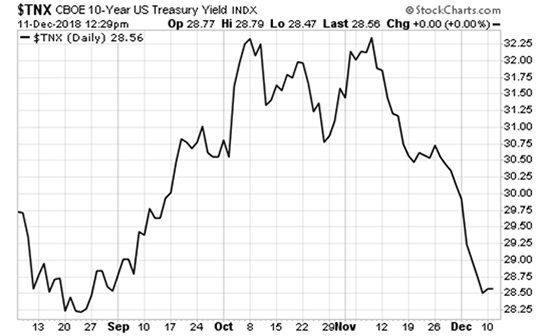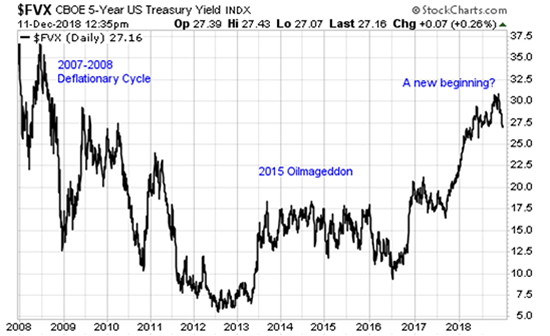This Is What The Market Fears Most
As the talking heads and market pundits wring their hands and spout off, it seems that the consensus bogeyman is an inverted yield curve. But what is that exactly?
| —Recommended Link— |
| Good News: Crash Insurance For Just $167 Smart people usually don’t take crazy risks. There’s only a tiny 0.03% chance that your house will burn down this year. That’s just one in 3,000. But you still pay for insurance, just in case. Now here’s what we don’t get: there’s a 41% chance our president is going to be impeached… maybe even booted out of office… and millions of investors are facing that risk head-on. History shows that could cut your entire portfolio by 48%. Good news though: you can hedge against that possibility for just $167. Get all the details here… |
In literal terms, when short-term bond rates are higher than longer rates or the spread between them is narrow, things can get weird. Markets and investors tend to favor a steep yield curve. Higher long-term rates suggest inflation which suggests higher economic growth which begets corporate earnings growth. The result is higher stock prices.
Sounds like the “If You Give a Mouse a Cookie” book I used to read to my kids when they were little.
Let’s look at some bond yield charts. Here’s the 10-year Treasury:

In a nutshell, the yield on the 10-year rose 13% then fell 11.6%. That’s a serious move in both directions. While an increase at that rate is inflationary, a decrease that rapidly could be considered deflationary.
And at the end of the day, deflation is what the market fears most.
What does deflation look like on a chart? This 10-year chart of five-year Treasury bond yields tells the tale.

Put simply, deflation is when prices on everything fall, especially assets. That’s the primary reason the irrationally scared will flock to gold. It’s shiny. It’s perceived to hold value. Drug dealers and Bond villains love it.
#-ad_banner-#Try buying a bag of rice at a Sam’s Club with Krugerrands.
Deflation is natural with a slowing of the business cycle. Some signs do hint at slowing economic conditions in the U.S. economy. The most notable category is corporate earnings.
S&P 500 corporate earnings, the holy grail of market indicators, are projected to grow by 8.3% for 2019. Compare that to the projected 22.7% growth for this year. The case for deflation is crystal clear.
Does this mean that 2019 will be a total train wreck? Not necessarily. 8.3% is better than -5.4%. But, a 63% haircut is alarming.
So, what do investors do? Sell it all and buy dry food, water, and ammunition?
Absolutely not.
But, if deflation is a real possibility it makes sense to select stocks of companies that do well in deflationary environments. They’re the usual suspects: healthcare, utilities and consumer staples. Typically, these companies do well when input costs and interest rates (i.e. borrowing costs) are tangibly lower. These types of stocks are also usually strong dividend payers. Therefore, if there’s little upside due to sluggish markets, you’ll be getting paid.
Here are some of my favorite ideas.
Healthcare — My two favorites in this space are CVS Health Corp (NYSE: CVS) and AbbVie, Inc. (NYSE ABBV). After its mega merger with health insurer Aetna, CVS is now what the integrated, healthcare company of the future should look like with its hand in everything healthcare, including providing primary care. Shares trade at a cheap forward PE of 10.55 and a 2.72% dividend yield.
After splitting the company in two, AbbVie became the traditional pharma business of the old Abbott Labs (NYSE: ABT) while the new Abbott Labs focused on devices, consumer healthcare and systems. AbbVie concentrates its efforts on research and development in the oncology, inflammatory disease, and neurological disorder drug space. Again, a cheap forward PE of 11 with an attractive 4.88% dividend yield.
Utilities — Although I’m partial to U.S. utility giant Southern Company (NYSE: SO), going forward I like National Grid, PLC (NYSE: NGG) as a place to commit new money. Domiciled in the U.K., National Grid has a much larger footprint covering regulated electrical generation and natural gas distribution in the United States and Great Britain. Internally, the company’s metrics are attractive with a return on equity of 18%, much higher than the ROE of its American peers. Shares trade at a reasonable forward PE of 13.5 with a tempting 5.8% dividend yield.
Consumer Staples — Slow economies and choppy markets go great with consumer staples stocks. One of the strongest staples ideas out there today is Warren Buffett’s favorite food company: Kraft Heinz (NYSE: KHC). Rolling up two of the biggest in the packaged food business, KHC brings it with a huge portfolio of global brands. From ketchup to cheese to coffee to luncheon meat, open your fridge or pantry, it’s in there. The stock trades with a bargain forward PE of 13.4 with a solid 5.15% dividend yield.
| —Recommended Link— |
| Don’t Go Broke Chasing Dividend Checks Since 2013, one income investment has been knocking it out of the park. In fact, the “Guaranteed Income Strategy” has banked 191 winners out of 211 trades — generating a $140,490 windfall. If collecting instant cash and winning 90.5% of the time sounds good to you, then grab the details on how you can pocket your first instant cash this Wednesday. |
Risks To Consider: A sudden slowdown in economic growth might not result in full-blown deflation. It could crop up in certain sectors and not appear in others. A lot of that depends on how pessimistic the mood is. Even with decelerating growth, earnings growth, positive, net growth is still in the forecast. One never knows. The names discussed are about as defensive as they come, and all have solid operating franchises that should perform well under multiple economic scenarios.
Action To Take: As a basket, all four stocks trade at a forward PE of 12.11 which is a 26% discount to the forward PE of the S&P 500 index. With a blended dividend yield of 4.63%, more than double that of the index, and the value biased price of the stocks, investors should enjoy good income, stability, and the possibility of some upside even if things do get a little ugly.
